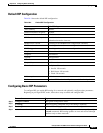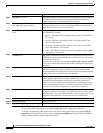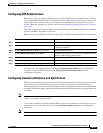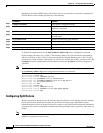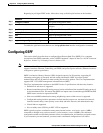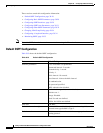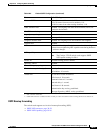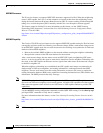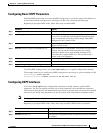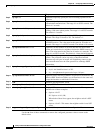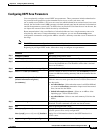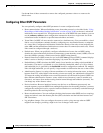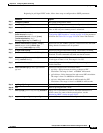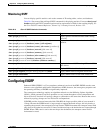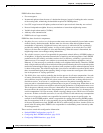
38-29
Catalyst 3750-E and 3560-E Switch Software Configuration Guide
OL-9775-02
Chapter 38 Configuring IP Unicast Routing
Configuring OSPF
Configuring Basic OSPF Parameters
Enabling OSPF requires that you create an OSPF routing process, specify the range of IP addresses to
be associated with the routing process, and assign area IDs to be associated with that range.
Beginning in privileged EXEC mode, follow these steps to enable OSPF:
To end an OSPF routing process, use the no router ospf process-id global configuration command.
This example shows how to configure an OSPF routing process and assign it a process number of 109:
Switch(config)# router ospf 109
Switch(config-router)# network 131.108.0.0 255.255.255.0 area 24
Configuring OSPF Interfaces
You can use the ip ospf interface configuration commands to modify interface-specific OSPF
parameters. You are not required to modify any of these parameters, but some interface parameters
(hello interval, dead interval, and authentication key) must be consistent across all routers in an attached
network. If you modify these parameters, be sure all routers in the network have compatible values.
Note The ip ospf interface configuration commands are all optional.
Beginning in privileged EXEC mode, follow these steps to modify OSPF interface parameters:
Command Purpose
Step 1
configure terminal Enter global configuration mode.
Step 2
router ospf process-id Enable OSPF routing, and enter router configuration mode. The
process ID is an internally used identification parameter that is
locally assigned and can be any positive integer. Each OSPF
routing process has a unique value.
Step 3
nsf (Optional) Enable NSF operations for OSPF on a
Catalyst 3750-E switch.
Step 4
network address wildcard-mask area area-id Define an interface on which OSPF runs and the area ID for that
interface. You can use the wildcard-mask to use a single
command to define one or more multiple interfaces to be
associated with a specific OSPF area. The area ID can be a
decimal value or an IP address.
Step 5
end Return to privileged EXEC mode.
Step 6
show ip protocols Verify your entries.
Step 7
copy running-config startup-config (Optional) Save your entries in the configuration file.
Command Purpose
Step 1
configure terminal Enter global configuration mode.
Step 2
interface interface-id Enter interface configuration mode, and specify the Layer 3 interface
to configure.



